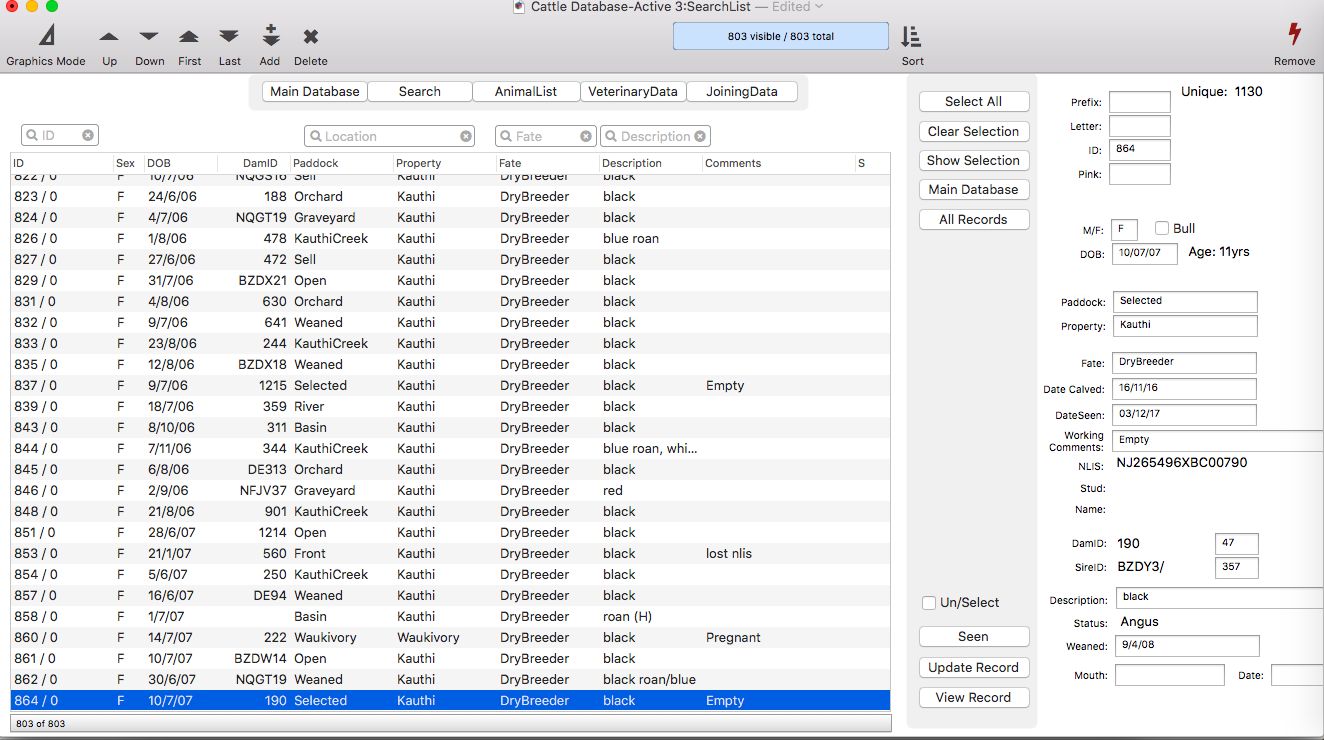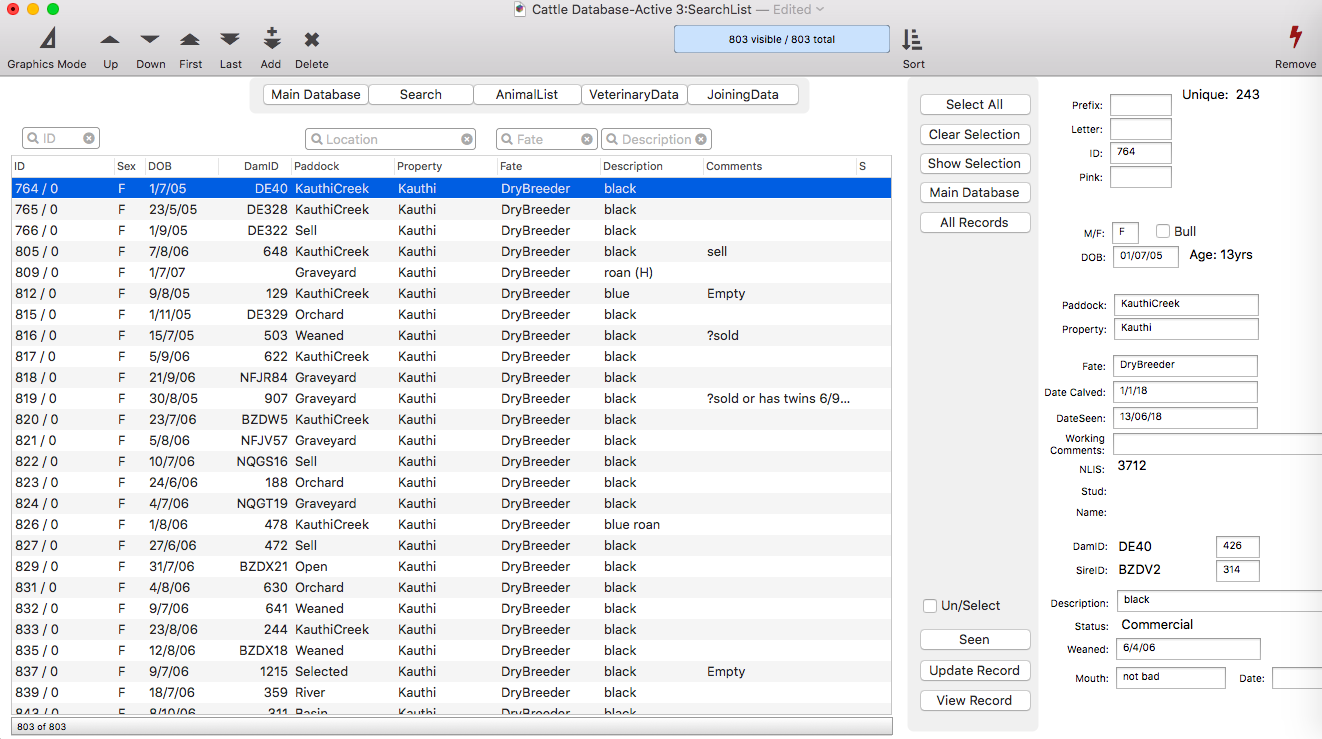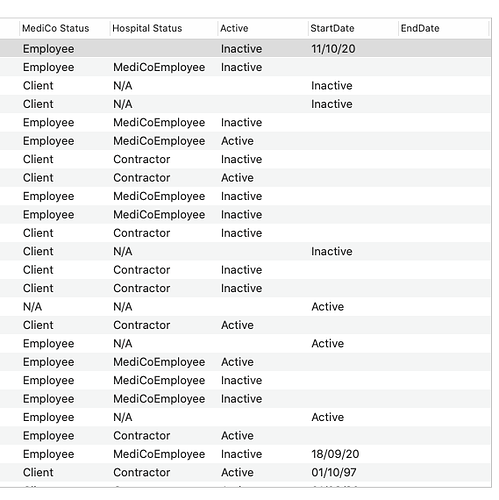The customer’s file I’m working with now has 110,478 records (customers) and the file is 42 mb. It’s very, very slow.
The problem is that in Pano 6, a 41 MB, 41,000 record file does a real ‘live’ search and the resulting select takes 76 ticks. Unfortunately going forward, Pano 6 is not an option.
Robert Ameeti
Robert, do you use text lists is the 41k record file? If so, what strategies have you used to get the best speed?
The speed results I listed, were from Panorama 6.
Robert Ameeti
My text list intermittently behaves erratically. I’ve discovered the need for all records to be available in the database, but randomly the database navigation just stops working. Usually when I try to select a record, it defaults to the first record in the database, but on the occasion in this screenshot, I’m trying to select the animal “831” and its jumping between “864” (as shown) and “764”. This has happened multiple times in previous months. If I quit the programme and start again, it keeps performing the same way. I’ve tried unchecking, and then checking, the database navigation option, with no effect. However, if I give up and wait a few days, the next time I start, it will be back to business as normal (hopefully).
Any thoughts or suggestions?

I’ve just reread my post, and recognised the similarity in numbers of 864 and 764. Considering these are completely random, as far as I can tell, the similarity in number struck me. Therefore I’ve attached a screenshot of the 764 occurrence, in case this offers any clues. (So, I’ve clicked on the record “831” immediately on from the previous screen shot, and this is what has happened)

New problem.
I have a database with financial information that I have grouped by date, done some totals, and then collapsed to outline level 1. I have a text list showing 4 columns, set to info(“visible”) and database navigation checked on. I want to be able to chose the line of data to be viewed, and then go to a new form showing a lot more information about the data. However, the database navigation doesn’t work in this situation. Am I asking it to do something you wouldn’t expect it to be able to do??
I have similar tables elsewhere, with one column, and select from the list to define a variable by which I then search. If I can’t do plan A (above), plan B would be to use this setup. However, how do I direct Panorama which column to make a variable? I had thought it would create an array from the selection, but if I message the variable (to see what it is), it just shows a blank…
Plan C will be to use the search functions…
Any help appreciated.
Thanks
I’m sorry, the database navigation feature will not work with summary records. This feature relies on the unique id embedded in each record, and summary records don’t have a unique id (the id of a summary record is always zero).
When the navigation option is enabled, the variable specified in the form object properties is ignored.
Have you looked into the summary table feature? I think this might be better for the custom solution you are looking for.
For your detail view, you could use the aggregate( function to calculate the totals on the fly.
A hint – if you use these functions you will not need to group, total and collapse your database. Simply opening the form would display the analysis. This would not be a “push one button to create the solution” option, but I think would allow you to create exactly what you are looking for.
Added note on this – I have submitted a change to the documentation explaining that the Database Navigator option doesn’t work with summary records. This is unfortunately not a bug that can be fixed, but a consequence of some fundamental design decisions that would be extremely expensive to revise at this late date (and even at an earlier date, I’m not sure how the design could have been revised to handle this, the server version in particular relies on summary records having an ID of zero).
Thanks Jim, I’ll look into both these options. Really loving working with PanoramaX now (that I start to understand it better).
Hi Jim,
The summary table is certainly a better (fantastic) option for what I’m trying to do.
I’m working with dates, so I’ve discovered the groupdatepattern(. Is it possible to have the dates displayed in the opposite order (most recent at the top of the table?). Also I note that this is only for summary table type things. I have the same issue with presenting dates in lists generally, and have had to get around this by displaying the YY/MM/DD format in order to have them display in chronological order, but that format is suboptimal for the user interface. Can the groupdatepattern( be expanded to text lists as well?
No, sorry, there is no option to reverse the order, but I’ve added it to the list.
Well, it already works with Text Lists when used with the summarytable( function. It doesn’t make any sense to use groupdatepattern( directly with a Text List, but I understand what you are getting at, and I’ve sometimes wished for something similar as well, so it has been added for future consideration.
I wrote a custom statement that will sort an array by a column other than the first one. It can sort up or down, and can sort alphabetically or numerically. It can sort correctly if the column contains a currency symbol. With this function, you can sort a text list by an array column that is not displayed in the text list. You can find the statement and function in the Database Exchange, named Arraysortbycolumn.
Or you could use the arraymultisort statement or function.
I took her request as wanting this to work directly in a Text List, without any additional code to set up the data. If there is code that sets up the data in advance into a variable, then you can definitely write code to add the sort you need. And for now, that is the only way to do it.
Another example of text lists behaving strangely:
You can see that the columns get out of line. I’ve had this happen very rarely in several of my databases. Is usually a reproducible problem - never figured out why.
It looks like you might be importing data with two tabs after “N/A” and only one tab after anything else.
Is this from the same database? I assume that the data sheet looks ok? If there is an extra tab character at the end of some data cells, that would not show up in the data sheet, but would show up like this in a Text List. The Text List object is really not designed to show data that actually contains tabs, it assumes that tabs are only used as a separator between columns. It’s generally pretty difficult to get a tab character into a Panorama cell, but not impossible. You can easily strip them out with the Morph>Current Field dialog.
Fixed!
I couldn’t imagine how I would get tabs into a field, because when I press tab, it moves to the next field, but… I had choices nominated for the field of Active Inactive N/A and there was a tab sitting invisibly after the N/A, populating it when I chose that option
One way to get a tab into Panorama is by copying it from some other program and pasting it into Panorama.
